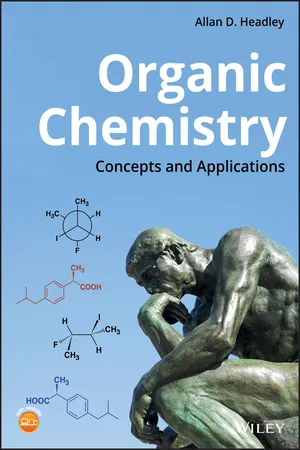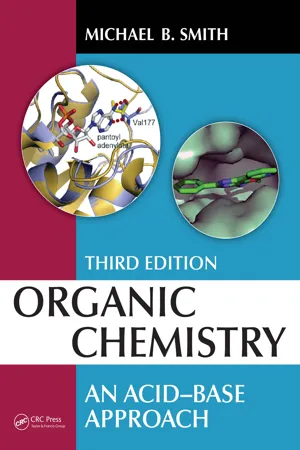Chemistry
Chemical Properties of Benzene
Benzene exhibits several important chemical properties, including its stability due to the delocalization of electrons in its aromatic ring. It undergoes substitution reactions rather than addition reactions due to its aromatic nature. Benzene also participates in electrophilic aromatic substitution reactions, where an electrophile replaces a hydrogen atom on the benzene ring.
Written by Perlego with AI-assistance
Related key terms
Related key terms
1 of 4
Related key terms
1 of 3
5 Key excerpts on "Chemical Properties of Benzene"
- eBook - ePub
- James G. Speight(Author)
- 2019(Publication Date)
- Gulf Professional Publishing(Publisher)
Aromatic hydrocarbon derivatives are derived from benzene. Group members have six free valence electrons which are distributed in a circle in the form of a charged cloud. Because of the presence of these valence electrons, we can predict that the reactivity of these aromatic compounds will be similar to other unsaturated hydrocarbon derivatives. However, benzene is much less reactive than other unsaturated hydrocarbon derivatives. Only at high temperatures and in the presence of a catalyst can benzene take on another hydrogen atom. When it does, cyclohexane is the resultant product.5. Physical properties
Physical properties can be observed or measured without changing the composition of matter. Physical properties are used to observe and describe matter (Howard and Meylan, 1997 ; Yaws, 1999 ). The three states of matter are: solid, liquid, and gas. The melting point and boiling point are related to changes of the state of matter. All matter may exist in any of three physical states of matter. A physical change takes place without any changes in molecular composition. The same element or compound is present before and after the change. The same molecule is present throughout the changes. Physical changes are related to physical properties since some changes require a change in the three-dimensional structure of the molecule.Physical properties that are of interest in the current context include: (i) boiling point, (ii) density and specific gravity, (iii) dew point, (iv) flash point and ignition temperature, (v) melting point, and (vi) vapor density. These properties are listed in alphabetical order rather than attempt to assign importance to any individual property. The properties present indications the behavior of hydrocarbon derives as determined by application of standard test method (Speight, 2015 ).The physical properties of alkene derivatives are similar to those of the alkane derivatives. The boiling points of straight-chain alkenes increase with increasing molar mass, just as with alkanes. For molecules with the same number of carbon atoms and the same general shape, the boiling points usually differ only slightly, just as would be expected for chemicals in which whose molar mass differs by only one to two hydrogen atoms (i.e., RCH2 CHCH2 compared to RCH2 CH2 CH3 - eBook - ePub
Organic Chemistry
Concepts and Applications
- Allan D. Headley(Author)
- 2019(Publication Date)
- Wiley(Publisher)
Benzene is another one of these organic compounds with a very distinctive aroma and is responsible for the odor of coal distillate. It was discovered that these organic compounds all have a special feature, which is described as aromaticity, and as result, these compounds are referred to as aromatic compounds. As you can imagine, there are numerous compounds that can be described as aromatic compounds. There are other aromatic compounds that may not have a distinct characteristic odor. Some include aspirin, morphine, norepinephrine, epinephrine, nicotine, vitamin E, and estrone. It is difficult to study all aromatic compounds individually, so we will carry out our study of aromatic compounds on the most common aromatic compound, benzene, and apply the knowledge gained to other compounds that are similar and aromatic.Benzene was isolated from compressed illuminating gas in 1825 by Michael Faraday of the Royal Institution. In 1834, Eilhardt Mitscherlich of the University of Berlin synthesized benzene by heating benzoic acid with calcium oxide and he also showed that the molecular formula of benzene is C6 H6 . Today, benzene is obtained primarily from the distillation of petroleum, and it is used in the synthesis of many useful chemicals in our society. Benzene is also a very common solvent that is used in most chemical labs, both industrial and academic. However, it was removed from teaching labs, since it was shown to cause cancer when given to laboratory animals in very large dosage. Benzene is absorbed in the blood stream from inhalation and is converted to phenols and excreted by the liver. Benzene causes skin irritation; it is thought to cause leukemia. If absorbed in the blood, it will increase the number of white blood cells and it also causes damage to bone marrow. However, it is still sometimes used, under very controlled conditions, in industrial and research labs.Since most of the chemical properties of compounds in this very large category of aromatic compounds are similar, we will study in detail the chemistry of only one of these compounds, benzene. By knowing the chemical and physical properties of benzene, we will be able to predict the properties of other aromatic compounds. In this chapter, we will first define aromaticity in a chemical sense and then apply that definition to other molecules to determine if they are aromatic or not. In the later sections of the chapter, we will examine the reactions of aromatic compounds.17.2 Structure and Properties of Benzene
It was shown that the chemical formula of benzene is C6 H6 . Based on our knowledge of the number of hydrogens that are bonded to the carbons of saturated hydrocarbons, it is obvious that benzene is not a saturated hydrocarbon. In 1866, Friedrich Kekulé proposed that benzene had a cyclic structure with three alternating double bonds, as shown in Figure 17.1 - eBook - ePub
Understanding Advanced Organic and Analytical Chemistry
The Learner's ApproachRevised Edition
- Kim Seng Chan, Jeanne Tan;;;(Authors)
- 2016(Publication Date)
- WS EDUCATION(Publisher)
As with the trend for homologues of each homologous series, the melting and boiling points of arenes increase with the increase in molecular mass. This is because an increase in molecular mass is associated with an increase in the number of atoms in the molecule, thus resulting in an increase in the total number of electrons. The greater number of electrons contributes to a more polarizable electron cloud, leading to stronger id–id interactions. The boiling point of benzene is about 80° C.6.3.2 Solubility
As with all hydrocarbons, arenes are soluble in non-polar organic solvents and insoluble in polar solvents. Benzene used to be an excellent solvent for organic compounds, but things have changed since it was found that benzene is toxic and carcinogenic. With similar solvent properties and being less toxic, methylbenzene has replaced benzene as a common solvent in the laboratory.6.4 Chemical Properties of Benzene
In order to “retain” the added stability brought about by the delocalization of pi electrons over the network of six carbon atoms, benzene undergoes mostly substitution reactions, in contrast with an alkene molecule. As the more “loosely” bounded pi electrons are available, benzene is an attractive site for strong electrophiles to attack. Benzene does not behave chemically the same as alkenes. This difference is clearly seen in their behavior towards the same reagents:• When Br2 in CCl4 is added separately to cyclohexene and benzene, there is instant decolorization of reddish-brown Br2 observed when it is mixed with cyclohexene. No decolorization of Br2 is observed when mixed with benzene.• When cold alkaline KMnO4 (aq) is added separately to both hydrocarbons, decolorization of purple KMnO4 (aq) and a brown precipitate of MnO2 (s) will be observed for cyclohexene but not benzene.Benzene does undergo addition reactions only when reaction conditions are harsh enough. For instance, it can undergo hydrogenation, using a nickel catalyst, and be converted to cyclohexane. But this reaction requires a much higher temperature (150–250° C) and pressure (25 atm) compared to the hydrogenation of cyclohexene. - eBook - ePub
Organic Chemistry
An Acid-Base Approach
- Michael B. Smith(Author)
- 2022(Publication Date)
- CRC Press(Publisher)
19 Aromatic Compounds and Benzene Derivatives
DOI: 10.1201/9781003174929-19The video clips for this chapter are available at: https://routledgetextbooks.com/textbooks/9780367768706/chapter-19.phpThe scientist photographs are also available at: https://routledgetextbooks.com/textbooks/9780367768706/image-gallery.phpBenzene was identified as a special type of hydrocarbon in Section 5.9. Benzene and derivatives are aromatic hydrocarbons with one ring or several rings fused together. The aromatic character of benzene and derivatives have special stability, which imparts a unique chemical profile.To begin this chapter, you should know the following points:- Resonance and resonance-stability (Sections 2.6 and 6.3.1).
- Nomenclature and structure of alkenes, alkyl halides, alcohols, amines, aldehydes, and ketones (Sections 5.1, 5.2 5.85, and 5.6).
- Carboxylic acids and carboxylic acid derivatives (Chapter 18 ).
- The structure and nature of π-bonds (Section 5.1).
- Reactivity of alkenes (Sections 10.1–10.6).
- E2 elimination reactions of alkyl halides (Sections 12.1–12.3).
- E1 elimination reactions (Section 12.4).
- The CIP rules (Section 9.2).
- Electron-releasing and withdrawing substituents (Sections 3.8, 6.3.2).
- Brønsted-Lowry acid-base reactions of alkenes (Sections 10.5–10.7).
- Carbocation stability (Sections 7.2.1, 10.1 and 10.3).
- Leaving groups (Sections 11.1–11.3 and 18.4).
- Lewis acids and Lewis bases (Sections 2.7 and 6.8).
- Rate of reaction (Section 7.11).
- Reduction of functional groups (Sections 17.2–17.5).
19.1 Benzene and Aromaticity
Structure of BenzeneBenzene is a liquid first isolated from an oily condensate deposited from compressed illuminating gas by Michael Faraday (England; 1791–1867) in 1825. Benzene is a hydrocarbon and the parent of a large class of compounds known as aromatic hydrocarbons. In 1834, Eilhard Mitscherlich (Germany; 1794–1863) established the formula to be C6 H6 and named the material benzin. Justus Liebig (Germany; 1803–1873) changed the name to benzol. In 1837, August Laurent (France; 1807–1853) proposed the name pheno (Greek; I bear light) since it was isolated from illuminating gas. The name was not adopted, but has given rise to the term phenyl for a benzene ring used as a substituent C6 H5 - eBook - ePub
- James G. Speight(Author)
- 2010(Publication Date)
- Gulf Professional Publishing(Publisher)
cyclic alkanes) are differentiated from aliphatic hydrocarbons insofar as they contain a ring structure and form a homologous group of compounds. The first member of the series is cyclopentane followed by cyclohexane. Cycloalkanes are saturated compounds and, like linear alkanes, are not very reactive.Aromatic hydrocarbons are derived from benzene. Group members have six free valence electrons which are distributed in a circle in the form of a charged cloud. Because of the presence of these valence electrons, we can predict that the reactivity of these aromatic compounds will be similar to other unsaturated hydrocarbons. However, benzene is much less reactive than other unsaturated hydrocarbons. Only at high temperatures and in the presence of a catalyst can benzene take on another hydrogen atom. When it does, cyclohexane is the resultant product.5. Physical propertiesPhysical properties can be observed or measured without changing the composition of matter. Physical properties are used to observe and describe matter (Howard and Meylan, 1997 and Yaws, 1999 ). The three states of matter are: solid, liquid, and gas. The melting point and boiling point are related to changes of the state of matter. All matter may exist in any of three physical states of matter.A physical change takes place without any changes in molecular composition. The same element or compound is present before and after the change. The same molecule is present throughout the changes. Physical changes are related to physical properties since some measurements require that changes be made.Physical properties that are of interest in the current context include: boiling point, melting point, density, vapor density, flash point, ignition temperature, and dew point.5.1. Boiling points and melting pointsThe boiling point of an organic compound is the temperature at which the vapor pressure of the liquid equals the environmental pressure surrounding the liquid.The melting point
Index pages curate the most relevant extracts from our library of academic textbooks. They’ve been created using an in-house natural language model (NLM), each adding context and meaning to key research topics.
Explore more topic indexes
Explore more topic indexes
1 of 6
Explore more topic indexes
1 of 4




